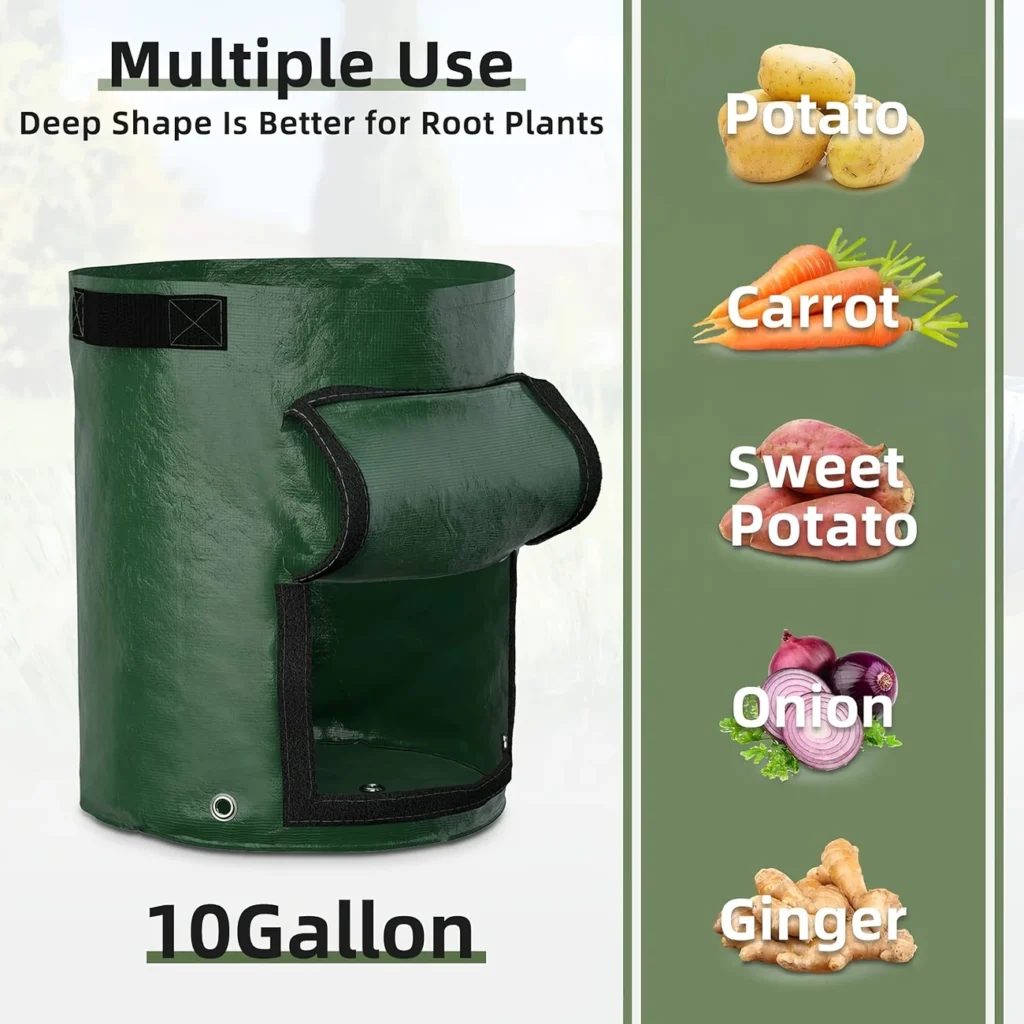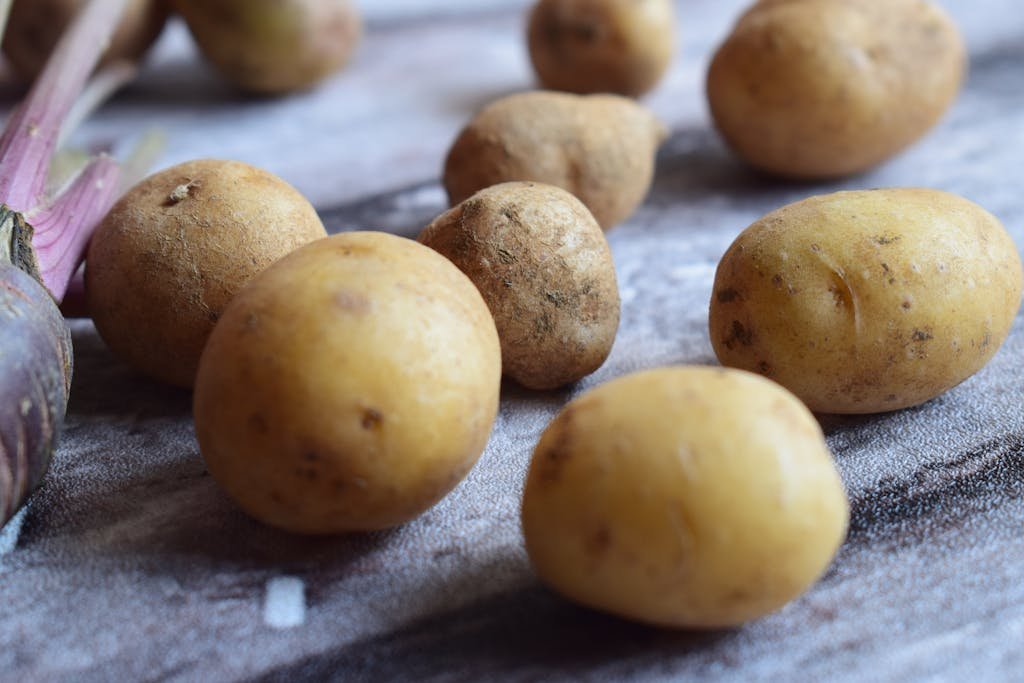
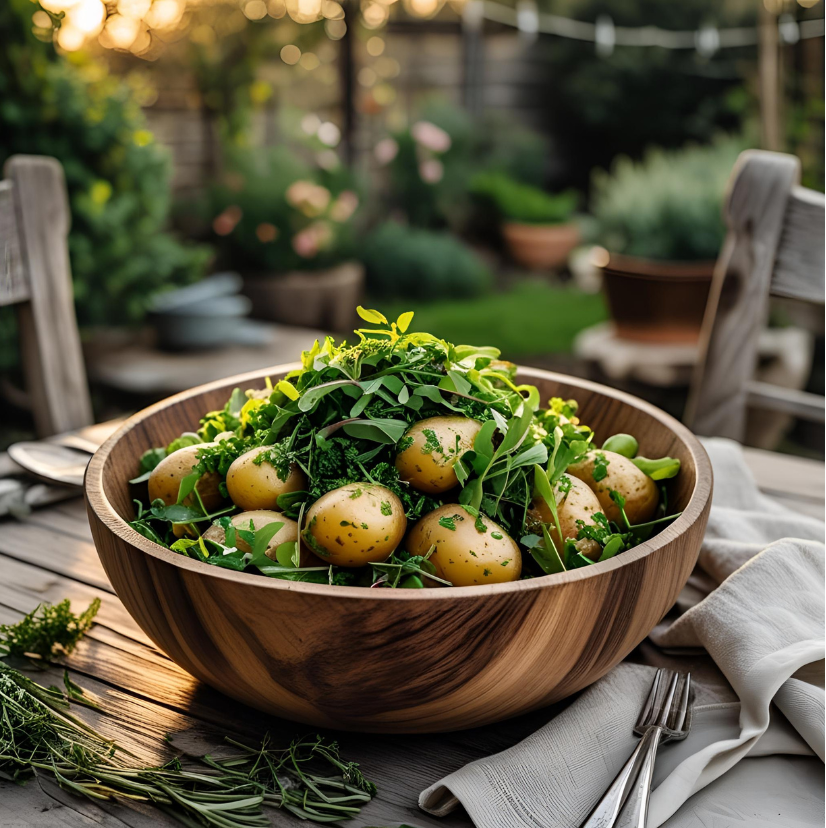
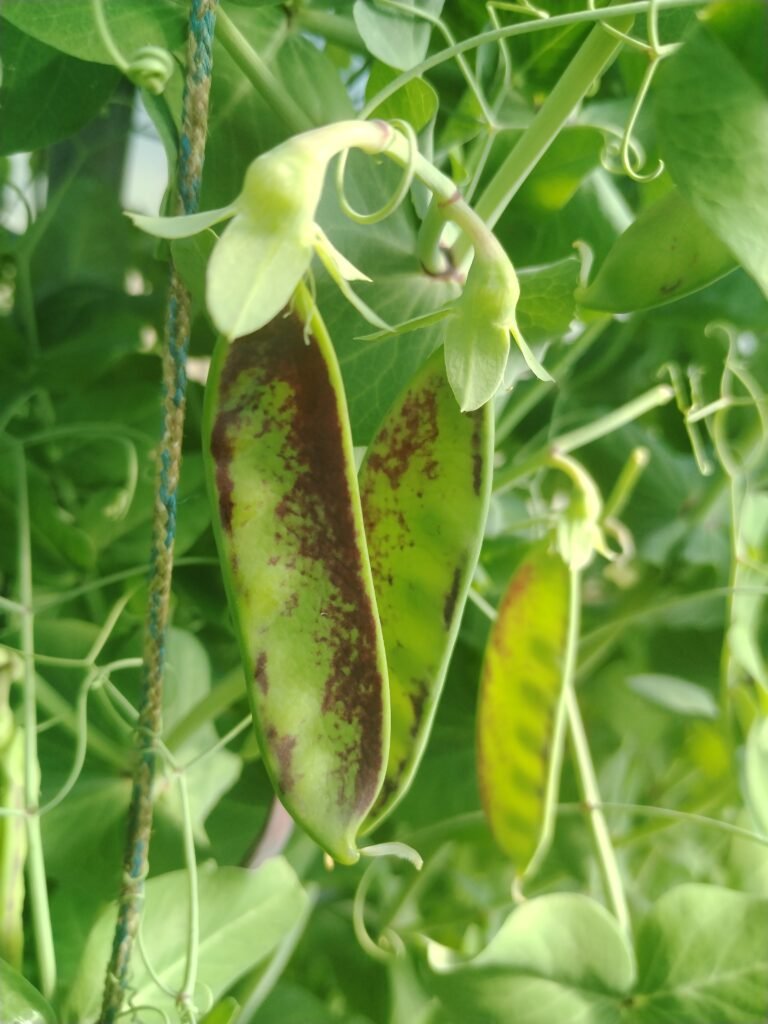
Few dishes taste more like spring than this Sorrel & Mangetout Salad with Warm New Potatoes. It’s fresh, zingy, and full of goodness straight from the garden.
In this salad, lemony sorrel meets sweet, crunchy mangetout. Add in soft, just-boiled new potatoes, still warm from the soil, and you’ve got something truly special. It’s the kind of meal that feels both light and hearty at the same time—perfect for lunch on a sunny day or as a side with dinner.
Even better? Everything in this dish can be grown in small spaces. You can harvest sorrel from your garden or forage it wild. Mangetout climbs happily in a pot or a corner of your veg patch. And those creamy new potatoes? They thrive in growbags on a balcony or patio. This recipe isn’t just about eating well—it’s about growing what you eat, right where you are.
If you’re picking produce from your own backyard, or filling your basket at the farmer’s market, this salad brings those flavors together in the most delicious way. It’s quick to toss together, deeply nourishing, and absolutely bursting with the taste of the season.
“Let food be thy medicine and medicine be thy food.” – Hippocrates
Growing New Potatoes in Small Spaces
If you’ve never grown your own potatoes before, don’t worry—it’s easier than it sounds. And even better, you don’t need a big garden. You can grow new potatoes in pots or [grow bags] right on a balcony, windowsill, or patio.
Start with the right variety
For this salad, you’ll want tender, waxy potatoes that hold their shape when cooked. Look for varieties like:
- Charlotte – buttery, smooth, and great for salads
- Maris Peer – soft, sweet, and quick to grow
- Lady Christl – early cropping and perfect when freshly dug
- Foremost – a lovely nutty flavor, ideal warm or cold
Use deep pots and rich compost
Choose containers at least 30–40 cm deep, like these sturdy grow bags or large planting pots. Fill with peat-free compost and mix in some organic fertilizer to give your spuds a good start.
Plant and top up as they grow
Bury the seed potatoes about 10 cm deep. As the plants grow, keep adding compost to cover the stems. This helps them grow more tubers.
Water regularly and harvest in 10–12 weeks
New potatoes are usually ready when the plants flower. Tip them out gently and enjoy them fresh—still warm, if you’re lucky!
Nutritional goodness
New potatoes are packed with:
- Vitamin C – supports your immune system
- Potassium – great for heart and muscle function
- Fiber – helps digestion and keeps you full
They’re low in fat and easy to digest, especially when boiled with the skins on.
Fresh, homegrown potatoes taste so much better than shop-bought ones—and they’re surprisingly easy to grow in small spaces.
Spring Onions – Easy, Fast & Flavorful
Spring onions are a dream for small-space gardeners. Not only do they grow quickly, but they also don’t need much room and are super easy to care for. Even better, they bring a fresh pop of flavor to just about any dish. In this salad, they add a lovely bite and a bit of zing—without overpowering the other ingredients.
Why they’re perfect for small spaces
First of all, spring onions have shallow roots. That means they’re ideal for [window boxes], [small pots], or even growing in between other plants. You can pop them in almost anywhere there’s a little bit of sun.
How to grow them
Next, sow seeds directly into the soil about 1 cm deep and 2–3 cm apart. You don’t even need a lot of space—just a little container and some [good compost]. For an ongoing harvest, sow a few rows every two weeks. That way, you’ll always have some on the go!
Ready to harvest in 8–10 weeks
Before you know it, you’ll be pulling up fresh green onions. Once they’re as thick as a pencil, go ahead and harvest. Gently tug from the base. Both the white bulb and green tops are edible—so nothing goes to waste.
Nutritional goodness in every bite
On top of all that, spring onions are little powerhouses. They’re:
- Packed with antioxidants, which help protect your cells
- Rich in vitamin K, which supports healthy bones and blood
- Full of digestive enzymes that can help your tummy stay happy
So, whether you’re just starting out or already have a few pots on the go, spring onions are a no-fuss crop with a tasty reward. Plus, kids love growing them—those little green shoots pop up fast, and it’s fun to watch them grow!
Mangetout – Crunchy, Climbing, and So Easy to Grow
If you’ve never grown mangetout before, you’re in for a treat. These sweet, crisp pods are a joy to grow and even more fun to eat. You can pick them straight from the vine and toss them right into your salad for that perfect garden-fresh crunch.
How to grow mangetout in small spaces
Mangetout (also called sugar snap peas) are perfect for patios, balconies, or even sunny windowsills. Since they’re climbers, they do need something to grow up—like a [trellis], netting, or even a few sticks tied together. You can plant them in a deep pot or a grow bag with good drainage. Just make sure to give them some support to latch onto!
Best varieties for small gardens
Not all peas are created equal—some are happier in tight spots than others. If you’re growing in containers or small raised beds, try these compact and reliable varieties:
- ‘Sugar Ann’ – a dwarf bush-type mangetout that doesn’t need support
- ‘Norli’ – early-maturing and great for container growing
- ‘Oregon Sugar Pod’ – semi-dwarf with lots of pods and a gentle, sweet flavour
These varieties keep things tidy and productive, making them perfect for anyone with limited space.
Best container tips
Use a pot or grow bag that’s at least 30 cm deep. Fill it with a mix of [compost] and soil, and make sure it stays moist but not soggy. Sow seeds about 5 cm apart and 2–3 cm deep. They’ll start sprouting in just over a week!
When to harvest
Pick mangetout when the pods are flat but firm—before the peas inside start to swell. The more you pick, the more the plant will give, so keep harvesting every few days for a steady supply.
Nutritional perks
Mangetout are loaded with goodness:
- High in vitamin C for your immune system
- Rich in fiber, which keeps your digestion happy
- Packed with vitamin K for bone health
They’re the kind of snack you’ll find yourself munching on while still out in the garden. Quick, sweet, and crunchy—they’re a natural fit for any salad or stir-fry, but they really shine in this one!
Foraging & Growing Sorrel
Once you’ve tasted sorrel’s sharp lemony bite, it’s hard not to fall in love. This zingy little leaf is one of those wild gems hiding in plain sight—and the best part? It’s just as easy to forage as it is to grow at home.
How to identify common sorrel in the wild
First things first—let’s make sure you’ve got the right plant. Common sorrel (Rumex acetosa) has long, arrow-shaped leaves with pointy tips and a distinctly citrusy tang. Give a leaf a nibble, and you’ll know right away if you’ve found the right one! Just be sure to avoid similar-looking plants like dock, which lack that lemony zap.
Where and when to forage safely
Look for sorrel in meadows, field edges, and grassy areas from early spring through summer. It grows low to the ground, often hiding among the grass. Choose clean, chemical-free areas—away from roads, footpaths, and sprayed fields.
Growing sorrel at home
If wild foraging isn’t your thing, no worries—sorrel grows beautifully in pots, window boxes, or garden beds. It’s a hardy perennial that comes back year after year and even self-seeds if you let it. Just give it a partly sunny spot and keep the soil moist but not soggy. You’ll have lemony leaves ready to pick in no time.
Nutritional values that pack a punch
Sorrel isn’t just tasty—it’s good for you too. It’s rich in vitamin C, iron, and antioxidants that support immune health and fight inflammation. It’s one of those greens that truly blurs the line between food and medicine.
Tips for using sorrel in the kitchen
Sorrel’s bright, tart flavour lifts everything from soups and pestos to sauces and salads. In this warm potato salad, it cuts through the starchiness and brings a fresh zip that’s hard to beat.
Why Seasonal Eating Is So Important
Eating with the seasons is one of the simplest ways to boost your health—and feel more connected to the world around you. When fruits and veggies are in season, they’re picked at their peak, which means more nutrients and better flavour. Plus, they don’t have to travel far to reach your plate, so they’re fresher and better for the planet too.
Even better, when you grow your own or buy from local farms, you know exactly where your food comes from. It’s fresher, tastier, and great for your gut—especially when you eat lots of different types.
Gardening and foraging also help you get outside and slow down. Instead of letting wild herbs and garden greens go to waste, you get to use them in delicious ways. It’s a lovely way to reduce food waste and care for nature at the same time.
And here’s the best part—seasonal eating supports your immune system. Spring foods are full of gentle greens and cleansing veggies that help wake your body up after winter.
A salad like this one shows off spring’s best: fresh sorrel, crunchy mangetout, soft new potatoes, and zingy spring onions. It’s bright, it’s simple, and it reminds you that the seasons have their own kind of magic.
Sorrel & Mangetout Salad with Warm New Potatoes
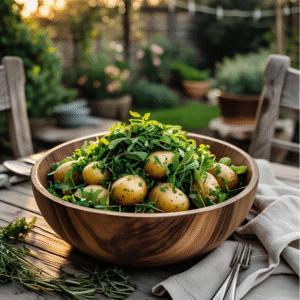
Sorrel & Mangetout Salad with Warm New Potatoes
Ingredients
- 500 g New potato
- 1 large Mangetout raw or lightly blanched
- 2-3 Spring onions finely chopped
- 1/2 Lemon zested
- 2 tbsp Olive oil
- 1 tsp Mustard wholegrain optional
- 1 tsp Honey or Maple syrup
- Salt and pepper to taste
Instructions
- Boil potatoes until just tender, drain, and halve while warm
- Blanch mangetout briefly or leave raw for more crunch
- Make dressing by whisking lemon juice, zest, olive oil, and mustard
- Assemble: toss potatoes, mangetout, and spring onions with dressing
- Add sorrel last to avoid discoloration, toss gently
Notes
- Sorrel is best added just before serving, as it can discolor when exposed to heat or acid for too long.
- Mangetout can be used raw for crunch or lightly blanched for tenderness.
- Add toasted seeds or crumbled feta for extra texture and protein.
- This salad is ideal for garden-to-table eating and works beautifully with homegrown or foraged ingredients.
Conclusion
This Sorrel & Mangetout Salad with Warm New Potatoes isn’t just a tasty lunch or side—it’s a little plate full of the season’s best gifts. Each bite reminds us how joyful and nourishing it is to eat what’s growing right now, whether that’s from your garden, a foraging walk, or a friendly farmer’s stall.
What makes this salad so special isn’t just the flavors. It’s knowing where your food comes from. It’s that moment when you pull up your first new potato or snip spring onions straight from a pot on your windowsill. Even if you only have a balcony or a few pots by the back door, growing something small can bring big joy.
Plus, these ingredients are packed with goodness—vitamins, minerals, and antioxidants that help your body feel its best. When food is fresh and local, it really is more nourishing. And when you grow or gather it yourself, it feeds your soul too.
So next time you’re thinking about what to make for lunch or dinner, remember this salad. Simple, beautiful, and full of flavor—just like summer should be.
If you’re looking for more garden-fresh ideas and seasonal inspiration, head back to our main June guide here and see what else you can grow, forage, or cook this month.
And as always—let the garden lead the way.

